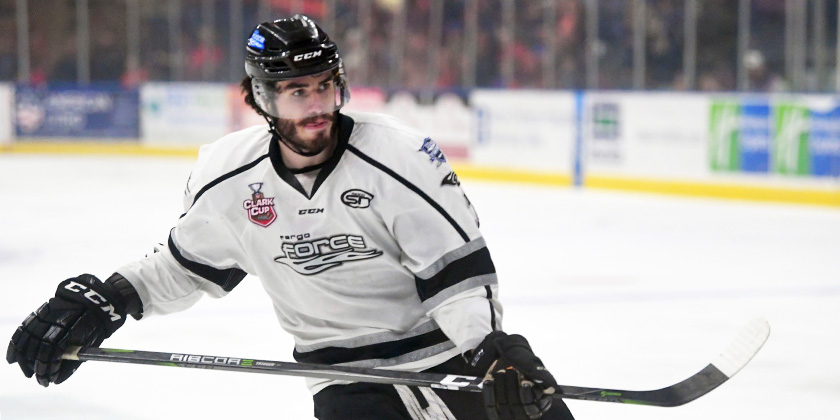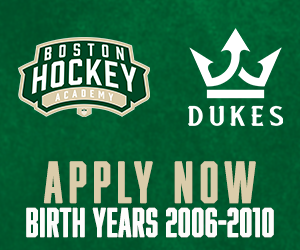by Jashvina Shah
On May 11, 2018, the first day of the Clark Cup final, Griffin Loughran and Ty Farmer stared into Youngstown’s bench. Fans were packed into Scheels Arena, giving Fargo’s rink the loudest atmosphere it housed all year.
It made sense, as the puck was about to drop on Fargo’s fourth-ever Clark Cup Final. But for Loughran and Farmer, the series contained something more than just a quest for the Force’s first-ever USHL championship.
Farmer and Loughran had both played for Youngstown before joining Fargo in an attempt to revive their USHL careers. Both skaters were second-chance players or, in Farmer’s case, a third-chance player.
“I always kind of took it as they didn’t really want me, so it was kind of a chip on my shoulder type thing,” Farmer said. “I was going to refuse to lose. I couldn’t go down to those guys, especially my old team. It was every bit of it on the line for each and every one of us, and everyone in the locker room knew how much it meant to me, and Griffin as well.”
Farmer and Loughran’s stories are a microcosm of the league, as many players have skated for multiple USHL teams or even multiple junior leagues. But it’s uncommon to see team rosters comprised of 50 percent or more of those “second-chance” players.
The Force rostered 11 players who’d skated for a different USHL team and seven players who’d appeared in a different junior league. Of the team’s 23-man roster, 18 players had come from somewhere else.
So when Fargo walked into the playoffs and won their first series, a sweep over Tri-City, the team likened itself to another band of misfits that also won its first playoff series with a potpourri of players pulled from other teams — Las Vegas.
Much like the Golden Knights, the Force found themselves on their league’s biggest stage. But unlike Las Vegas, Fargo lifted its championship trophy.
***
Farmer was just 16 years old when he joined Youngstown following his U16 season with the St. Louis AAA Blues. In his first season in the USHL, he skated in 39 games and netted five points. The next season, Farmer played in 19 games before shattering his collarbone. He returned in 2016-17, where he spent 29 games with Youngstown before requesting a trade to Muskegon. He was traded again, finally ending up with Fargo for the 2017-18 season.
By the time he found the Force, Farmer had spent three seasons in the USHL with two different teams, had broken his collarbone and had decommitted from Michigan State. He spent the summer shooting pucks in his basement to improve his accuracy and stickhandling, but his confidence was still struggling at the beginning of the year.
“I was down on myself earlier in the year and [the coaching staff] told me they’re going to keep giving me a chance no matter how many mistakes I make,” Farmer said. “They let me play, so that was great.”
Head coach Cary Eades’ approach worked, and Farmer finished with a career-high 39 points over 58 games. He led all Force defenders in scoring and broke the franchise record for points by a blueliner — formerly held by current Las Vegas defender Nate Schmidt.
“Coach Eades knows the correct way to play the game systematically, but I feel this season he really let me play my style of game and be in the rush more often and make sure I take care of the D Zone and do the little things right before I do anything offensively,” Farmer said. “I think he really taught me the core values of being a hockey player.”
Farmer also found a new commitment, choosing UMass. While he settled on the school because of the culture and coaching staff, Farmer was also intrigued by the team’s future.
“It’s an underdog team, it’s a comeback team and I think they’re going to be really good in the future so it’s something that I wanted to be a part of,” Farmer said. I’d rather not go to a powerhouse so I’d rather come from behind, so I think it’ll be good.”
Farmer admitted the mindset of an underdog game from his trying four-year USHL journey.
“Yeah. I didn’t want to be greedy about anything,” Farmer said.
***
Last season Fargo finished third in the conference and clinched a playoff spot. The Force fielded three players who accrued over 60 points in Blake Lizotte, Hank Crone and Jack Adams, who each scored 65, 62 and 60 points, respectively.
But in the offseason, Fargo lost 95 percent of its scoring and retained just six players from last year’s roster, all of whom made few contributions.
“To be totally honest, we thought it was going to be a rebuilding year. … It was a situation that we thought was probably going to be a two-year process,” Eades said. “We were looking for as many two-year players as possible but also supplementing them with some one-year players that would give us a chance to compete and contend.”
Despite the hodgepodge group that made it out of training camp, Farmer knew the Force were a championship-caliber team.
“Our chemistry was great from day one,” Loughran said. “We all knew that this is our second chance. We’re probably not going to get a third, so we wanted to make the most of it and that kind of jelled us throughout the season. We became super close to the team really early on, which I think was a huge help to our success.”
Fargo started the season well and continued that momentum into winter break. But when the season resumed, then-leading scorer Jacob Schmidt-Svejstrup missed 20 games while with Denmark at the World Junior Championship. Then in January, the team suffered injuries and a few suspensions.
“On the ice, things started to become more simple for each of us,” Farmer said. “We could understand how each other plays and where each guy would be in certain situations and how other teammates think. But off the ice, I think it really just comes down to being together off the ice. We were a really close-knit team, we hung out a lot away from the rink and I think that’s a huge part of our success this year. When we get together that builds that extra chemistry that you need and forms that jel on the team.”
The adversity reminded Fargo it needed to fix its play. The Force had to re-find themselves and their game but escaped the period with a couple big wins. And later on in the season after a game, the opposing team’s coach came up to Eades and shook his hand.
He told Eades: “Looks like you got the boys and the band back together.”
***
In 2015-16, Loughran scored 114 points over 74 midget games with the Buffalo Jr. Sabres U16 team. His performance drew attention from the Phantoms, who drafted him in 2016. Loughran joined Youngstown, and Farmer, for nine games before being sent down to Corpus Christi of the NAHL. After 32 games and 20 points at that level, Loughran was re-drafted by Fargo in 2017’s Phase II draft.
“Just being down in Corpus I matured as a player and realized what it takes to play junior hockey,” Loughran said. “[I] just tried carrying what I learned down there into Fargo. [We had] some good players throughout the whole season and I really grew more into the hockey aspect and growing up off the ice.”
Loughran entered Fargo with 95 junior hockey penalty minutes to his name. The coaching staff asked him to smarten up, and he learned to twist his energy into positive plays. The Northern Michigan recruit still ended up with 118 penalty minutes, but he also scored 42 points.
“We agreed to have, just keep my mouth shut for the most part and just aggravate them by not talking,” Loughran said. “That seemed to have really worked out in the playoffs, so that was good.”
Loughran also scored a team-high seven goals in the playoffs and was named playoff MVP.
“Sometimes players get hot. Each of our lines, for at least one playoff series, went off,” Loughran said. “It was just our turn to step up and I think we did that and obviously a little puck luck there.
“I don’t think I looked once when I shot it, I just kind of closed my eyes and shot it. It was just right time right place I guess.”
***
Loughran capped off his playoff performance with four points against the Phantoms. Farmer, meanwhile, scored the championship-clinching goal with just 3:54 left in Game 4, breaking a 2-2 tie.
“I made a D-to-D pass in the neutral zone. I was originally thinking to jump in the play but I didn’t want to do anything out of the ordinary and leave my defenseman on an odd-man rush, but I went for it,” Farmer said. “I went D to D, we passed it up to Schmidt-Svejstrup and I had some speed as he passed it to the blue line. He touched it to me and I already had speed and there was a little lane, like a little hole there, and I just slid right through and I shot it.
“It was really unexpected. I didn’t think that lane was going to be there, but it’s just the way of the game I guess. Capitalize on their mistakes.”
Fargo finished the season with 48 wins total and 81 points in the regular season, just three shy of the league-leading Anderson Cup championships. In the playoffs, Fargo also defeated Omaha and Waterloo en route to the final.
“Early on in the beginning of the season, we used that to our advantage a lot and kind of out-competed players that were in the league prior. We knew we had to work for our spots,” Loughran said. “That kind of went away as soon as we realized that, hey, we can play in this league and we can be really good in this league when we play as a team. That helped with bonding too, and it was really beneficial.”
Fargo may have won its first championship in program history, but the team also developed many of its second-chance players. Farmer and Schmidt-Svejstrup both made the All-USHL Second Team. Schmidt-Svejstrup went from seven points over 29 games with Dubuque to 43 points over 40 games with Fargo.
“Every player is a piece of clay that you’re trying to mold into a nice statue by the end of the season,” Eades said. “You’re not always successful. You treat players similarly as far as rules and etc., but you have to learn what buttons to push and what methods of coaching they accept best and what they do best as a player and then trying to minimize their weaknesses. I think that’s, in a perfect world, you’d be a great coach if you’re right on in all of those areas. That’s the mission. It’s not 100 percent, but that’s what we try to do and it just kind of fell together with these second chancers.
“As Vegas was developing their momentum during the season, we kind of related ourselves to them and a lot of guys in our team had a chip on their shoulder. They were out to prove people wrong, to prove that they could play in our league and contribute to a winning team. Having a chip on your shoulder, having a little edge, having a little something to prove, is always good for an athlete.”
Photo credit: Hickling Images





